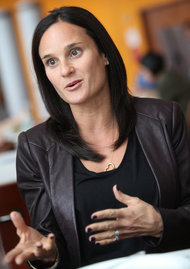She Owns It
Portraits of women entrepreneurs.
 Suzanne DeChillo/The New York Times Susan Parker, owner of Bari Jay.
Suzanne DeChillo/The New York Times Susan Parker, owner of Bari Jay.
At the last She Owns It Business Group meeting, the owners talked about several pricing issues. Susan Parker, who owns Bari Jay, recently discovered that customers react not only to a price increase but also to the way it is presented. When she learned her factories were raising her prices, she thought she would pass along a 10-percent-per-dress increase to all of customers. But then she had another idea.
Bari Jay customers who paid their invoices within 30 days had been receiving an 8 percent discount. Rather than increasing dress prices for all customers, Ms. Parker decided to discontinue the discount. This seemed like a good idea because it would affect fewer accounts, and the timely payers would still end up paying less than they would if she increased prices 10 percent across the board. But when customers learned they would be losing their discount for prompt payment, they were angry and confused, Ms. Parker said.
“I could see that,” said the group member Alexandra Mayzler, who owns Thinking Caps Group. “I’d feel like I’d been being so good, paying early, and you’re taking that opportunity away from me.”
With hindsight, Ms. Parker realized where Bari Jay went wrong. When she and her sister sent letters to the discount recipients, they said simply that Bari Jay was eliminating the 8 percent discount. The news might have been better received had they stressed that the discontinuation was in lieu of a 10 percent increase. “We only gave them the negative without giving them the positive, so the perception was that we’re taking something away,” she said.
“I think understanding that these things are going to happen, and building contingencies into your contracts — if you have a contract-type business — helps,” said Jessica Johnson, owner of Johnson Security Bureau.
Shifting gears, Ms. Parker said Bari Jay’s biggest pricing challenges are in Europe and Australia. While the company sells directly to stores in the United States, it sells through distributors in Europe and Australia, and the relationships with those distributors were in place before Ms. Parker and her sister took over the company.
Recently, Ms. Parker’s Australian distributor claimed it could increase Bari Jay’s business if it received a bigger discount. Ms. Parker said she was glad to offer one given the promise of more sales. But Bari Jay found that the change resulted in a decline in revenue. “The distributor must have made more money but it came from our pockets, not from increased sales,” she said.
Ms. Parker had agreed to offer the bigger discount for a trial period that ended about six months ago. But because Bari Jay didn’t speak up when the trial ended, Ms. Parker said she and her sister now feel stuck with the discount.
“Did they know it was a trial period?” asked Deirdre Lord, who owns the Megawatt Hour.
“They did,” Ms. Parker replied. Sometimes, she added, she wonders whether she and her sister are “suckers.” She said they walked into a meeting with the distributor saying, “We’re going back to our original discount.” But they found neither of them had the nerve to push for the result they wanted.
“Are you afraid that they’re going to stop carrying your line?” Ms. Lord asked.
Ms. Parker doesn’t think that would happen — it doesn’t cost the distributor all that much to keep the line. But she said she has learned from her experiences with stores in the United States that they seem to promote the lines of their favorites. So, she said, she is wary of becoming “the person they don’t love dealing with.” Already, Ms. Parker suspects her Australian distributor isn’t promoting Bari Jay as much as it does other lines. For example, she said the distributor advertises other lines in all four issues of Australia’s leading bridal magazine but only advertises Bari Jay in two issues.
Ms. Lord said it sounds like Bari Jay may have a marketing issue, not a pricing one. That is, it’s not Bari Jay’s prices that are affecting sales, but the way in which the distributor is marketing the company’s dresses.
In Europe, Bari Jay’s distributor claims he needs a bigger discount to improve sales, which have fallen significantly. Ms. Parker is considering offering a discount that incorporates a minimum order. But she’s not sure. “If I do this and it doesn’t work, well then how do you renege?” she asked.
Why wouldn’t Ms. Parker just conclude that Europe isn’t her market? Ms. Mayzler asked. “You don’t want to have a price that’s not actually working,” she said.
But Ms. Parker stressed that Bari Jay has been successful there. At their peak, she said European annual sales were about $500,000, or one-fourteenth of Bari Jay’s revenue — with minimal labor costs. The dresses ship directly from Asia, at the distributor’s expense, so Bari Jay isn’t responsible for packing and unpacking. She said her labor is basically limited to order entry and invoicing. “So, it’s mostly profit,” she said. But now, European sales are close to zero — not profitable at any cost.
“What happened?” Ms. Mayzler asked.
“Europe keeps saying the market changed,” Ms. Parker said. She acknowledged that the region’s economic woes aren’t helping. But she suspects other issues are at play. She recently learned the distributor buys all of his other lines directly from factories, not retailers like Bari Jay, which mark up the factory’s price. “I can’t compete when he’s getting direct from a factory and I’m a middle man,” Ms. Parker said. “He’s selling my dresses next to a dress for half the price.”
Ms. Mayzler suggested that the problem is the distributor, not the discount amount. Ms. Parker acknowledged she is searching for a new European distributor. But until she finds one, she said she would like to see at least some European business. A bigger discount may offer her current distributor an incentive.
“Dare I say it’s not worth being in Europe?” Ms. Lord asked.
“It is though, because I can do half a million dollars, why wouldn’t I want that?” Ms. Parker replied.
“It depends how much it costs you,” Ms. Mayzler said.
You can follow Adriana Gardella on Twitter.
Article source: http://boss.blogs.nytimes.com/2013/06/05/trying-to-take-the-sting-out-of-a-price-increase/?partner=rss&emc=rss

